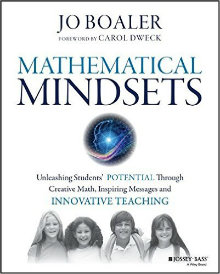Mathematical Mindsets: Creativity and Innovation
Mathematical Mindsets: Unleashing Students’ Potential Through Creative Math, Inspiring Messages and Innovative Teaching
By Jo Boaler
(Jossey-Bass, 2016 – Learn more)
 Reviewed by Anthony Jones
Reviewed by Anthony Jones
I’ve long been a fan of the work of Carol Dweck and the idea of growth mindset. In this book, Stanford professor Jo Boaler takes that concept and applies it specifically to mathematics. In fact, the foreword is written by Dweck.
Middle school mathematics educators (really, all mathematics educators) should embrace this book and understand how much of an impact the way mathematics is taught can have on students – not only in math class but also across the entirety of a student’s education.
 Boaler has laid out a wonderful book that is full of factual research on the brain and mathematics education. She has included ways that these ideas tie into real world situations. She has provided many ways for educators to incorporate these ideas into the classroom, and has provided many sample problems or lesson ideas to utilize in the classroom.
Boaler has laid out a wonderful book that is full of factual research on the brain and mathematics education. She has included ways that these ideas tie into real world situations. She has provided many ways for educators to incorporate these ideas into the classroom, and has provided many sample problems or lesson ideas to utilize in the classroom.
Best of all, each chapter has a conclusion that really summarizes exactly its key points, helping us synthesize all the information presented.
More about what’s in the book
Boaler begins by explaining the latest on the brain and mathematics learning. While she cites research from several studies, it is presented very well and is very accessible to the general reader. In good teaching fashion, she sets the stage for how this research should impact the classroom and how we teach mathematics.
She immediately follows this up with how we view mistakes in math. So often mathematics instruction has focused on the “right” answer as opposed to the process of getting an answer. As a result, many educators and most students have a lack of understanding of how mistakes in math should be viewed and how mistakes can actually enhance the brain’s development.
Mathematics is about patterns
Chapter 3 dives into the creativity and beauty to be found in mathematics. Again, for most of our educators and students, mathematics is about numbers and equations and solutions. As Boaler puts it:
Mathematics is a cultural phenomenon: a set of ideas, connections, and relationships that we can use to make sense of the world. At its core, mathematics is about patterns.”
I would love to encourage every teacher of mathematics – whether as a primary concentration or as a part of the general classroom – to memorize that one statement. It is the crucial piece to helping students to become successful as math learners.
One idea I found very worthy: “Math Homework Reflection Questions.” This approach focuses not on coming up with math problems to get answers but rather creating math questions that actually helped students learn. This is a radical departure from the normal homework seen in a math class.
Classroom case studies
Instead of writing about mathematics in a technical and abstract way, Boaler uses the next few chapters to talk about rich mathematical tasks from actual cases she has observed in classrooms. She follows with questions that challenge educators to try to incorporate these ideas into their own classrooms. At the conclusion of this chapter, she gives a list of incredible resources that will be welcomed by dedicated math teachers .
In chapter 8 Boaler challenges the reader to think about how they use assessments in the classroom. As with all of her work, she includes examples from real-life classrooms that she has observed. She also talks about the success and effectiveness of each of these ideas.
Back to growth mindset
In the last chapter, Boaler takes the time to suggest specific ways that educators can teach mathematics for a growth mindset. These include:
- Teaching mathematics as a subject of patterns and connections
- Teaching creative and visual mathematics
- Encouraging intuition and freedom of thought
- Valuing depth over speed
- Connecting mathematics to the real world
- Using technology and manipulatives
Each of these suggestions is accompanied by examples and ideas to utilize in the classroom with specific problems that can become stand-alone lessons.
Finally, the Appendix may be the best reference a math teacher could have at his or her disposal – a wealth of resources, problems, tasks and ideas contained within this last section of the book.
I have added Mathematical Mindsets to our mathematics library and encouraged all of our math teachers to take the time to read this book and make a plan to implement the ideas in their own classrooms. If you teach math on any level, I do not think there is a better resource to have on your shelf.
Anthony Jones (@MathGuru7) is an educator, technology assistant and team leader within his district. He has been teaching math for 11 years. He is a fan of using Twitter for educational purposes and regularly contributes to #educhats, including #tlap, #txeduchat, and #bfc530. He has a passion for student success and integrating curriculum with technology and real-world applications.

































